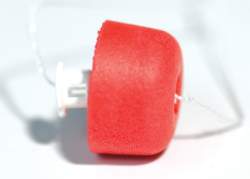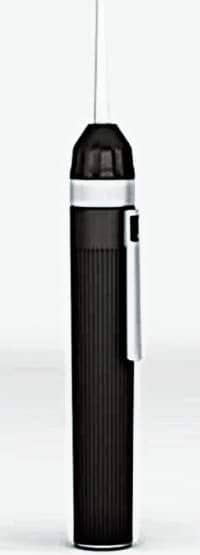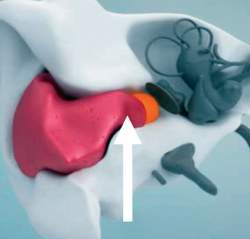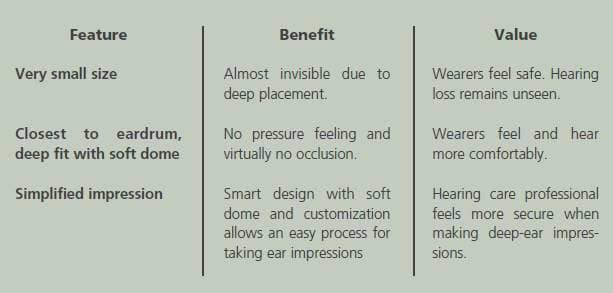A new tool and method for achieving deep-canal impressions and devices
Since at least the early 1990s, the hearing care literature has shown the definite advantages of “going deep” relative to the location of the hearing aid in the ear canal. Although CICs and other supposedly “deep-fitting” devices have become popular, most of these fittings never actually achieve a true deep fit because of the professional’s reluctance to make a deep-canal impression. This article looks at a new solution for achieving true deep-canal fittings for CICs, IICs, and other devices that might benefit from them.
As professionals in the hearing care industry, we all aim to achieve a fine balance between a wearer’s need for better speech intelligibility, preferred sound quality, and personal lifestyle preferences—cosmetics, robustness, comfort, etc. It is in this effort that we progress and evolve as an industry.
Discreetness has always been a driving force behind hearing aid design and manufacturing. For decades, completely-in-the-canal (CIC) and more recently IIC (invisible-in-the-canal) hearing aids have solicited considerable sums in R&D and sales, along with significant consumer desire and attention. Well-known obstacles to hearing aid adoption and common perceptions of hearing aid wearers1 may all factor into the drive for smaller, more discreet instruments.

Eric Branda, AuD, is senior manager of product management at Siemens Hearing Instruments, Piscataway, NJ.
There is a large variety of custom hearing aid options on the market today—all with varying forms and functions. Yet, it is consumer desire for invisibility and comfort that encourages manufacturers to develop smaller, deeper-placed hearing instruments.
Fitting hearing aids deeply into the external ear canal produces pleasing acoustic and aesthetic benefits.2-4 Deep-fitting hearing aids available today range from disposable, extended-wear, analog solutions to conventional digital hearing aids with a standard zinc air battery.
A Product with Strong Appeal to a Key Target Market
The deep-fit solution is positioned in the discreet segment that targets wearers whose main concern is hiding their hearing loss. This target group has a fear of being stigmatized by wearing hearing aids and considers the devices as part of the problem and not as a solution. The need for comfort is also a requirement due to the sensitivity and inflexibility of the bony portion of the external auditory meatus or ear canal. A discreet “disappearing hearing solution” gives wearers the confidence that people see their personality—not their hearing aid.
The market for deep-fitting solutions is backed by three distinct consumer needs:
- Discreet design. The product must be nearly invisible and designed so only the wearer realizes it is being worn.
- Comfort. The product must provide a very comfortable wearing and listening experience. This is particularly important to experienced wearers.
- Discreet usage. Wearers do not want to get caught making adjustments to hearing aids because this also highlights their hearing loss. They want—and expect—the absolute best in speech intelligibility regardless of the listening situation.

Figure 1. The new soft dome acts as an otoblock and is placed within the bony portion of the ear canal prior to impression taking. Each dome has a service life of about 2 to 4 weeks.
Advantages of Deep Canal Fittings
Today’s hearing instrument fittings are performed with careful attention to details, such as venting, compression ratios, insertion gain, and output. All considerations are for the comfort and benefit of the individual with hearing impairment. There are clear distinctions between BTE (behind-the-ear) hearing aids, standard CIC hearing instruments, and deep-fit solutions. Fitting hearing instruments deeply into the external ear canal—beyond the second bend—presents several advantages over the alternatives:
Increased gain and output. A deep canal hearing aid positions the tip of the shell or earmold extremely close to the eardrum, past the second bend and into the osseous (bony) portion of the ear canal. This proximity to the eardrum results in a minimal residual volume and consequently an increase in output at the eardrum compared to a shallower placement. Additionally, as the microphone is generally placed at the opening of the ear canal or deeper, there is an increase in high frequency gain offered by the pinna and concha.5
Diminished occlusion effect. The occlusion effect occurs when an object seals the outer portion of the ear canal, causing the wearer to perceive a hollow echoic sound in his/her own voice. In the case of hearing aid wearers, the effect is caused by sound vibrations trapped within the occluded ear canal.
Successful resolution to the occlusion effect is twofold: 1) obtain a solid seal in the bony portion of the ear canal, and 2) decrease the spatial placement between the tip of the instrument and the tympanic membrane, thus limiting the opportunity for vibrations. Experience in proper deep-fitting techniques can achieve such desirable results, with little to no resulting occlusion effect.6
Reduced acoustic feedback. The design and placement of deeply fitted hearing aids reduce feedback for multiple reasons. The decreased occlusion effect removes the need for significant venting, and the deeply seated seal against the bony portion of the ear canal eliminates two common feedback avenues. The receiver is positioned so closely to the tympanic membrane that there is less amplification needed to achieve the desired result. This allows less output and reduces the opportunity for acoustic feedback.7,8

Figure 2. A standard light stick can be used in the placement of the otoblock.
Retention and a secure seal. Traditional custom hearing instruments are seated in the cartilaginous portion of the ear canal. As the wearer’s jaw moves, custom CIC hearing instruments can become dislodged, causing gaps and openings and degrading ideal performance. The inward seated seal of a hearing aid fitted deep in the canal places the instrument in the bony portion of the ear canal. This prevents dislocation during jaw movement and provides a secure feeling and enhances wearing confidence.9
Maintained directionality. The placement of a deeply fitted hearing aid allows the shape and function of a wearer’s outer ear to operate as intended for gathering and filtering sounds before they enter the ear. Natural cues can aid a wearer in sorting through complicated acoustic environments, adding to the perception of natural sound quality. Traditionally fitted hearing aids often disrupt spectral cues due to the obstruction of the concha, placement of the microphone behind the pinna, and limited bandwidth for higher frequency cues.10Additional benefits have been reported, such as greater headroom, improved sound pressure levels, enhanced cosmetics, better intelligibility in phone conversations, and wind-noise reduction.9 Although some of these advantages have been attributed to traditional CIC hearing instruments, all of them apply—with even greater results—to deep-canal hearing aids.
Challenges in “Going Deep”
With such beneficial advantages, why aren’t more consumers fit with deep-fitting hearing aids? Or perhaps a better question is: Why aren’t hearing care professionals more apt to recommend a deep-fitting hearing aid during patient counseling and the selection and fitting process?
Custom hearing instruments begin with individual ear impressions taken of each patient’s ears, resulting in custom earmolds and hearing aid shells. Taking ear impressions is a crucial, everyday component in hearing aid dispensing and can be performed safely after attaining proper clinical training and experience. However, when it comes to deep-fitting methodologies, there is much debate—particularly over concerns and potential complications resulting from the deep-fitting process.
Hearing care professionals continue to voice clear concerns over the difficulty and time-consuming task of “going deep.” The following describes the challenges posed by deep canal fittings:
Discomfort. The vast majority of incident reports and adverse reactions to deep-canal fittings are related to the earmold impression process and the subsequent discomfort it can pose for the patient. While taking an ear impression can become a matter of routine for a hearing care professional, the procedure appears to be invasive to the patient and should be handled delicately. Since the impression material flows deeply into the external auditory meatus and requires full contact with the bony portion of the canal, a patient may experience a moderate level of discomfort.
Internal trauma. Anytime a deep ear impression is performed, the proximity of impression material to the tympanic membrane is always a cause for concern. Although otoblocks are an important part of standard practice when conducting deep fittings, rare complications with impressions may include canal abrasions, trauma to the tympanic membrane, and/or middle ear ossicles, and even progressive or long-term hearing loss.11
Embedded impression material. Hearing care professionals continue to debate the ideal impression-taking material for deep fittings. Impression material viscosity and confidence (or lack thereof) in the otoblock seal with the canal wall have dissuaded some hearing care professionals from pursuing deep-canal impressions due to the potential for residual damage to the tympanic membrane and middle ear. So, the risks of embedding impression material within the ear have served as a deterrent for deep-canal devices.

Figure 3. The new dome securely seals the ear canal without contacting the eardrum, assuaging concerns about trauma or residual impression material during the impression-taking process.
Specialized equipment and expertise. Specific deep-fit hearing instruments, known as extended-wear hearing aids, require specialized equipment and expertise to ensure proper placement. Such hearing aids are worn for 3 to 4 months at a time and cannot be removed or inserted by the wearer. For hearing care professionals and their staff, this means specialized equipment and training may be necessary to ensure a patient is fit safely and successfully. Such extended-wear hearing instruments also impose some limitations on wearers.
A New Solution for Deep Fittings
Considering these challenges, the question arises: Is there a secure, reliable, cost-efficient, deep-fitting process available today? A new deep-fit technique resolves many of these challenges by offering an impression process similar to the method hearing care professionals are more comfortable with and use daily. It’s a deep-fit process that avoids the typical deep-fit problems.
The new deep-fit solution consists of two parts: 1) a soft dome (Figure 1) that allows comfortable placement along the bony portion of the ear canal, and 2) a very small custom shell that contains the digital hearing aid technology.
This new deep-fit solution also includes a new, easy impression-taking procedure:
- With an otoscope (Figure 2), carefully inspect the ear canal for size and structural considerations and clean out any existing debris.
- Place the soft impression dome (Figure 1) on a regular light stick (Figure 2) and position it about 2 mm after the second bend of the ear canal.
- Use standard silicon impression material and equipment to inject the material in the patient’s ear up against the impression dome, following regular ear impression-taking procedures.
- The dome securely seals the ear canal without contact with the eardrum (Figure 3), preventing concerns of possible internal trauma or residual impression material.
- Removal is just as easy as before, with the double removal string of the impression dome.
- With the soft dome attached, the silicone impression can then be digitally or physically sent to the manufacturer.

Figure 4. The finished hearing aid (shown here in prototype) contains a dome on the end of the device with the same dimensions as the new deep-fitting dome, making it a truly deep-fitting aid without the risks of a deep-ear impression.
The finished hearing instrument contains a dome on the end with the same dimensions as the impression dome (Figure 4), making it a truly deep-sitting instrument built without the risks of a deep-ear impression.
Unlike traditional deep impressions that utilize a single-use otoblock, the attached dome is not discarded. In fact, one of the main advantages of this new impression-taking technique is that the dome now becomes a useful, necessary, and truly functional part of the ear impression. When the patient is fit, the deeply seated dome provides many of the advantages discussed above, including increased gain and output, significantly reduced occlusion effect, decreased auditory feedback, secure placement, and directionality.
The new deep-fit hearing instrument includes the smallest available components, making it extremely discreet, virtually invisible, and digitally advanced. It avoids the challenges outlined above, due to the enhanced ear impression method providing an easy, safe deep impression technique while the soft dome provides a truer fitting and enhanced wearing comfort. These deep-fit hearing aids can be easily removed and reset in place by the wearer. Consequently, wearers feel and hear confidently and comfortably.
Each soft dome has a usage life of 2 to 4 weeks, after which the wearer can simply replace the old dome with a fresh, new one. This ensures a clean, comfortable, snug fit and optimizes effective audibility and sound quality. Power is provided by a tiny 10A zinc air battery, with a variable device life depending on settings, usage patterns, and individual ear structure.
This simple fitting approach avoids the challenges and concerns that keep hearing care professionals from pursuing deep canal fitting technology. The result is a nearly invisible hearing instrument that enhances speech intelligibility and provides a more natural hearing experience.

Correspondence can be addressed to HR or Eric Branda, AuD, at .
References
- Kochkin S. MarkeTrak VII: Obstacles to adult non-user adoption of hearing aids. Hear Jour. 2007;60(4):32-51.
- Chasin M. The acoustic advantages of CIC hearing aids. Hear Jour. 1994;47(11):13-17.
- Mueller HG, Ebinger K. CIC hearing aids: potential benefits and fitting strategies. Sem Hear. 1996;17(1):61-80.
- Agnew J. Acoustic advantages of deep canal hearing aid fittings. Hearing Instruments. 1994;45(8):22-25.
- Gudmundsen G. Fitting CIC hearing aids—some practical pointers. Hear Jour. 1994;47(7):10, 45-48.
- Mueller HG. CIC hearing aids: What is their impact on the occlusion effect? Hear Jour. 1994;47(11):29-36.
- Staab W. Solving challenges in deep canal fittings, Part 1. Hearing Review. 1995;2(2):34-40.
- Staab W. Solving challenges in deep canal fittings, Part 2. Hearing Review. 1995;2(2):30-34.
- Staab WJ, Preves D. Deep canal hearing instrument fittings: a new approach. Hearing Review. 2000;7(6):50-53.
- Best V, Kalluri S, McLachlan S, Valentine S, Edwards B, Carlile S. A comparison of CIC and BTE hearing aids for three-dimensional localization of speech. Int J Audiol. 2010;49(10):723-732.
- Dillon H. Hearing Aids. New York, NY: Thieme; 2001.
Citation for this article:
Branda E. Deep Canal Fittings: Advantages, Challenges, and a New ApproachHearing Review. 2012;19(04):24-27.



